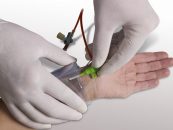Deferring treatment through angioplasty in non-ischemic lesions by fractional flow reserve (FFR) is associated with excellent long-term prognosis in patients with chronic ischemic heart disease. FFR is beginning to be used for clinical decision-making in patients with acute coronary syndromes, and its long-term effect on stable chronic patients has not been established. This…
Patients with Plaque Erosion: Management without Stenting
This small study presented at ESC and simultaneously published in the European Heart Journal evaluated patients undergoing acute coronary syndrome caused by plaque erosion identified by optical computed tomography (OCT). The study showed it can be managed with conservative antithrombotic therapy and without stenting. Patients with plaque erosion can receive dual antiplatelet therapy, ticagrelor and aspirin…
No Extra Benefit for Combined Use of Bivalirudin and Transradial Approach
The aim of this meta-analyzis was to study the relation between bivalirudin and access site in patients undergoing acute coronary syndrome (ACS). Both bivalirudin and the transradial access site are strategies aiming at reducing bleeding complication in patients with ACS undergoing invasive approaches. The interaction of both strategies and the potential benefits of their combined use…
STEMI: Best P2Y12 inhibitor according to network meta-analysis
Original Title: Optimal P2Y12 inhibitor in patients with ST-segment elevation myocardial infarction undergoing primary percutaneous coronary intervention: a network meta-analysis. Reference: Rafique AM et al. J Am Coll Cardiol Intv 2016;9:1036–46. Courtesy of Dr. Alejandro Lakowsky. Researchers drew up a network meta-analysis incorporating 37 trials with more than 88,000 patients undergoing ST elevation…
PRIME-FFR: Safe in acute coronary syndrome
Original Title: Impact of routine Fractional Flow Reserve on management decision and 1-year clinical outcome of ACS patients: Insights from the POST-IT and R3F Integrated Multicenter registriEs –Implementation of FFR in Routine Practice (PRIME-FFR). Presenter: Luís Raposo. Supported by a large body of evidence, the use of fractional flow reserve (FFR) has clearly been…
MATRIX: Transradial vs. Femoral Access in Non-ST Elevation AMI
Original Title: Radial versus femoral access in patients with acute coronary syndromes with or without ST-segment elevation. Presenter: Bernardo Cortese. The MATRIX study showed that the transradial access is associated with a reduction of combined events, death, infarction, stroke and bleeding, compared to femoral access, in ACS patients. The goal of this sub-analyzis was…
Conservative Management of MI risk in ACS
Original Title: Spontaneous MI after Non–ST-Segment Elevation Acute Coronary Syndrome Managed without Revascularization. The TRILOGY ACS Trial. Reference: Renato D. Lopes et al. J Am Coll Cardiol. 2016;67(11):1289-1297. Patients admitted with acute coronary syndromes (ACS) and especially those managed conservatively without revascularization, are at high risk of a new spontaneous infarction. However, MI risk rate…
DANAMI 3: Deferred Stenting and Ischemic Postconditioning Have No Benefit in Primary PCI
Both ischemic postconditioning and deferred stenting showed no benefit in randomized studies conducted as part of the DANAMI 3 program. Both the DANAMI 3-DEFER and the DANAMI 3-iPOSTshowed slight improvements in ventricular function after intervention, but clinical end points saw no change. This does not mean that outcomes should be considered negative, only that the…
Morphine Increases Platelet Reactivity in Infarctions
The use of morphine in patients undergoing ST elevation acute coronary syndromes is associated to higher platelet reactivity and lower thrombolysiscapacity, according to this small study. The negative effects seem to resolve 2 days after administration. This transient effect is believed to be the result of the inhibition of the normal muscular activity of the…
EARLY-BAMI: Metropol Showed No Reduction in Infarct Size.
EARLY-BAMI outcomes show the endovenous administration of metropol before primary PCI does not reduce infarct size. This double blind study randomized 683 STEMI patients within 12 hours of symptom onset to endovenous metropol (two 5 mg bolus, the first in the ambulance and the second before PCI) vs. placebo. Primary end point was infarct size…






